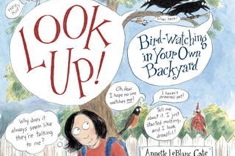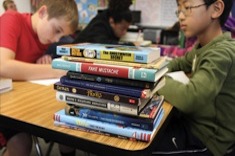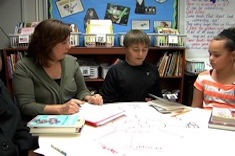My third graders love facts and information. Often their nonfiction reading lives consist of books that share lots of facts and isolated information about topics they love. I want to build on students’ enthusiasm for information and their sense of curiosity, but I also want to nudge them forward as readers.
When I think about nudging readers, I think about all that I’ve learned from Teri Lesesne’s Reading Ladders: “The goal of reading ladders is to slowly move students from where they are to where we would like them to be. With reading ladders you start with the authors, genres, or subjects your readers like, and then connect them to book after book—each a little more complex or challenging than the last.”
I’ve discovered that one way to scaffold students as nonfiction readers is to stock my classroom library with nonfiction that has more than one entry point. By "more than one entry point," I mean that there are different ways for a reader to enter the book and there's more than one way to experience the book. The books I’ve found usually have a “must-read” thread as well as “invitations” to dig deeper. Sometimes there is a narrative through the book and then additional facts on each page that are connected to the information in the narrative. At other times there are details that add to the main ideas on each page.
For readers new to nonfiction, these invitations give them ways to read and then revisit the book. Some readers may choose to read only the main text of the book, whereas others will dig into each page and the additional features. Through minilessons, we talk about how readers make decisions when reading and that some books are not intended to be read only in a linear way. We look at the ways in which the font and various features give us options for reading a book. We read through the main narrative of one book and then go back into the book to see what other invitations there are to dig deeper.
Since I’ve added many of these books to our classroom, I’ve realized how much this type of reading transfers to online reading, where readers decide whether to continue with the main text or to click on links and extras. Making decisions about how deep to go as a reader is an important skill for readers today. Informational books with more than one entry point serve many purposes.
Look Up! Bird-Watching in Your Own Backyard by Annette LeBlanc Cate is an informational book about bird-watching. Each page focuses on a different aspect of birds and bird-watching, and the author uses a variety of techniques to share information. This is a book that can be read cover to cover or enjoyed in little bits and pieces.
Volcano Rising by Elizabeth Rusch and Susan Swan tells the story of a volcano erupting. The text slows down the eruption with great language and sound effects. The illustrations include features that allow the reader to see the movement of materials over time. On each spread, the author has included additional information about volcanoes for those readers who want to know more.
Birds of a Feather by Bernadette Gervais and Francesco Pittau is an oversized book with a lift-the-flap design. Because of this, the book is immediately engaging for young readers. Under each flap is an interesting fact about birds. But the pages are organized in a way that invite conversations about bigger ideas. For example, one spread focuses on eggs, so readers can read isolated facts or think about ways facts on the page go together.
The Animal Book: A Collection of the Fastest, Toughest, Cleverest, Shyest—and Most Surprising Animals on Earth by Steve Jenkins is different from many of Jenkins’s other nonfiction books because it is bigger, with a great deal of information on many animals. This feels a bit like a child’s encyclopedia of animals, but of course Jenkins organizes the sections in ways that teach more than isolated information. Readers can read stand-alone pages about one topic, read sections that bring information together, or read the book cover to cover. There are many ways to enter and continue with this book.
Can We Save the Tiger? by Martin Jenkins shares the issue of animal extinction. In the main text, the author shares the importance of the tiger and why it is becoming extinct. Throughout the book, the author adds extra interesting facts in a smaller text size that go beyond the main narrative.
Forest Explorer: A Life-Size Field Guide by Nic Bishop is a guide to observing things in forests. The book is organized into sections that readers can dig into in whatever order they choose. But within each section, the author shares what to look for, as well as tips for field notes. The index is also helpful. Readers could use this book to learn new information or as a reference when visiting a forest to identify and learn about the things they see.
The Everything series from National Geographic Kids is a great series that readers can enter in different ways. Each title focuses on a topic that is interesting to children (for example, castles, dogs, and rocks and minerals), and the detailed table of contents allows readers to choose what they’d like to read about. Embedded in each book are a variety of text and design features that allow the reader to learn different information about the topic. Charts, graphs, captions, and diagrams invite readers to read beyond the main text.
See What a Seal Can Do by Chris Butterworth is another picture book with two parts for the reader. The main narrative tells the story of a gray seal. But there is extra information about seals on each page, in smaller text, that extends the story.
The Story of Snow: The Science of Winter’s Wonder is a basic story of how snow is formed, with details and diagrams that expand each concept. Readers will want to revisit this one to pay closer attention to the details and diagrams after understanding the main idea.
When Lunch Fights Back: Wickedly Clever Animal Defenses by Rebecca Johnson is a book packed with fascinating information on the ways different animals defend themselves against predators. The text and photographs provide interesting descriptions of ways animals defend themselves when attacked. The author has included a “Science Behind the Story” section on each page for readers who are interested in the scientific information that explains the defense.
Weird and Wild Animal Facts by Jessica Loy is a great next step for readers who typically enjoy isolated facts. This book is organized into two-page spreads, and each page focuses on a common animal (for example, giraffe, hummingbird, tarantula). But the book’s focus is on the uncommon characteristics, so readers learn some new and interesting things about each animal. Most facts are expanded to a few sentences to give details and explanations.
Feathers: Not Just for Flying by Melissa Stewart teaches readers about the many uses of feathers. The main text explains the uses of feathers by comparing them with things children are familiar with. The details on each page can be read by readers who are interested in the specific types of feathers and birds being discussed.









